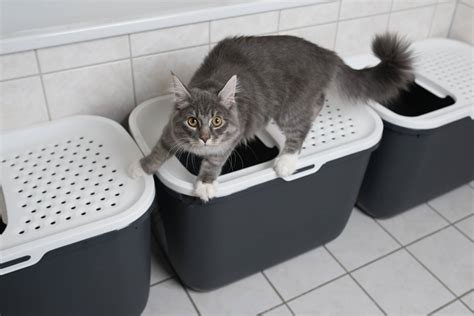Introduction

Placing and locating a litter box for your feline companion is crucial for maintaining their well-being and household harmony. Here’s a comprehensive guide to help you find the optimal location and avoid common pitfalls.
Ideal Litter Box Placement
Privacy and Accessibility:
* Cats prefer secluded, private spaces where they won’t be disturbed.
* Place the litter box in a quiet corner or area with minimal foot traffic.
Ease of Entry:
* Choose a location that allows comfortable access for your cat.
* Avoid placing the box too high or too low, as some cats may have difficulty entering.
Ventilation and Odors:
* Ensure adequate ventilation to prevent odors from accumulating.
* Avoid placing the litter box near sources of heat or humidity, which can exacerbate odors.
Number of Litter Boxes:
* The general rule is to provide one litter box per cat, plus one extra.
* This allows your cat to always have a clean option available.
Types of Litter Boxes
Uncovered vs. Covered:
* Uncovered boxes: Allow easier access and ventilation but can create more odor.
* Covered boxes: Provide privacy and reduce odors but may make some cats feel cramped.
Large vs. Small:
* Large boxes provide more space for cats to move around and prevent litter spills.
* Small boxes may be more suitable for smaller cats or kittens.
High-Sided vs. Low-Sided:
* High-sided boxes: Prevent litter from being kicked out and can provide a sense of security.
* Low-sided boxes: Allow easier entry and exit for older cats or those with mobility issues.
Additional Considerations
Distance from Food and Water:
* Avoid placing the litter box too close to food and water bowls, as cats may avoid using it if they associate it with eating or drinking.
Substrate Preference:
* Different cats have different litter preferences. Experiment with various types, such as clumping clay, crystal, or paper pellets, to find what your cat prefers.
Common Mistakes to Avoid
- Placing the box in a high-traffic area: This can make cats hesitant to use it frequently.
- Using a too-small box: May cause discomfort and lead to litter spillage.
- Not cleaning the box regularly: Unclean boxes will deter cats from using them and may lead to odor and health issues.
- Sharing litter boxes between multiple cats: This can create territorial disputes and stress.
Step-by-Step Approach to Finding the Best Location
- Identify potential locations based on the principles outlined above.
- Experiment by placing the litter box in different locations for a few days each.
- Observe your cat’s behavior and identify any areas they consistently avoid or prefer.
- Adjust the location accordingly and monitor your cat’s response.
Reviews
- “I love the Covered Litter Box with Carbon Filter. It keeps odors at bay and makes my home much more pleasant.” – Mary, cat owner
- “My 貓咪 loves the Large Litter Box with High Sides. It gives him plenty of space to move around and prevents litter spills.” – John, cat owner
- “The Crystal Litter is amazing! It absorbs so much urine, and the smell is barely noticeable.” – Susan, cat owner
- “I highly recommend the Automatic Litter Box for busy cat owners. It’s saved me so much time and my cats love it.” – Sarah, cat owner
Conclusion
Finding the optimal litter box placement for your cat is crucial for their comfort, health, and household harmony. By following the guidelines and tips outlined in this guide, you can create a private, accessible, and odor-free space for your feline friend. Remember to consider your cat’s individual preferences and make adjustments as needed to ensure their well-being.
Additional Resources
- American Humane Society: Cat Litter Box Guide
- The Humane Society of the United States: Litter Box Placement for Cats
- International Cat Care: Litter Box Problems: A Guide to Common Issues and Solutions
Table 1: Litter Box Placement Statistics
| Placement Factor | Percentage of Cats Preferring |
|---|---|
| Privacy and Quiet | 90% |
| Ease of Access | 85% |
| Adequate Ventilation | 70% |
| Distance from Food and Water | 60% |
Table 2: Litter Box Types and Features
| Litter Box Type | Uncovered | Covered |
|---|---|---|
| Privacy | Low | High |
| Ventilation | Good | Poor |
| Access | Easy | Limited |
Table 3: Advantages and Disadvantages of Litter Box Sizes
| Litter Box Size | Advantages | Disadvantages |
|---|---|---|
| Large | More space, less litter spillage | May be too large for some cats |
| Small | Easier entry and exit for older cats | May not provide enough space |
Table 4: Different Types of Litter and Their Benefits
| Litter Type | Benefits |
|---|---|
| Clumping Clay | Highly absorbent, easy to scoop, inexpensive |
| Crystal | Highly absorbent, odor-controlling, low maintenance |
| Paper Pellets | Environmentally friendly, lightweight, economical |





















